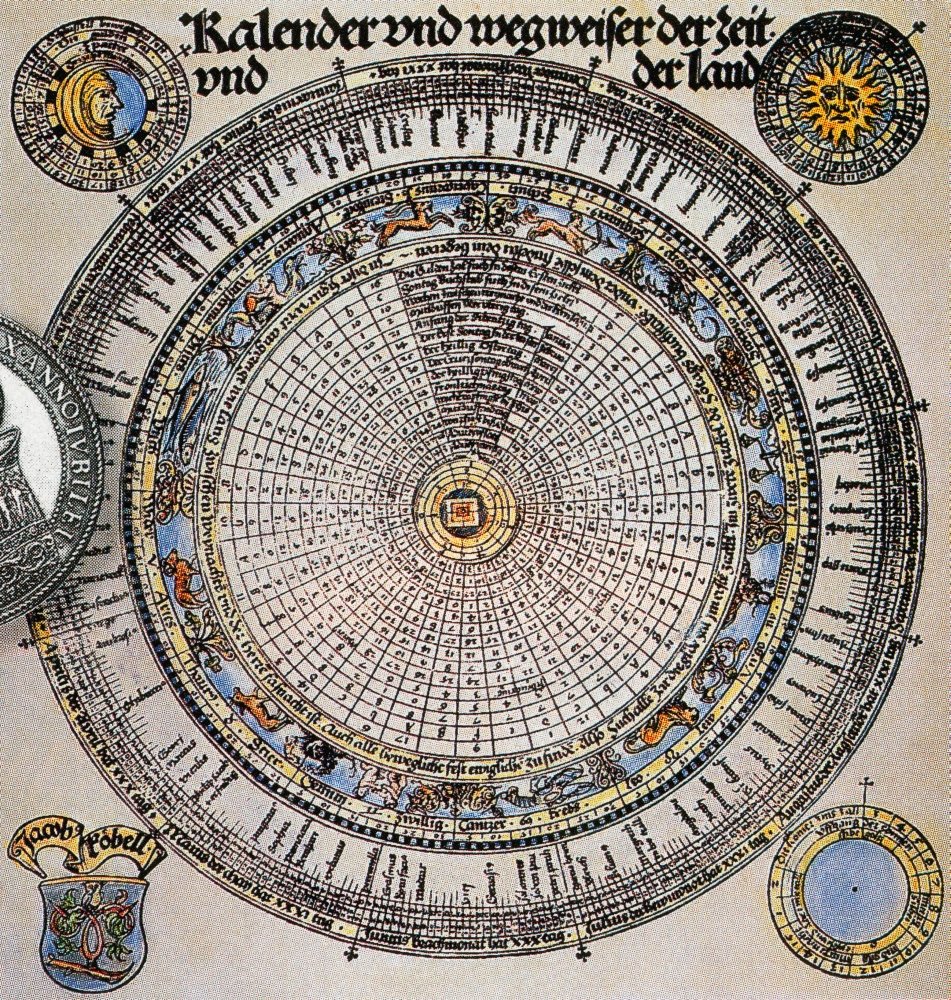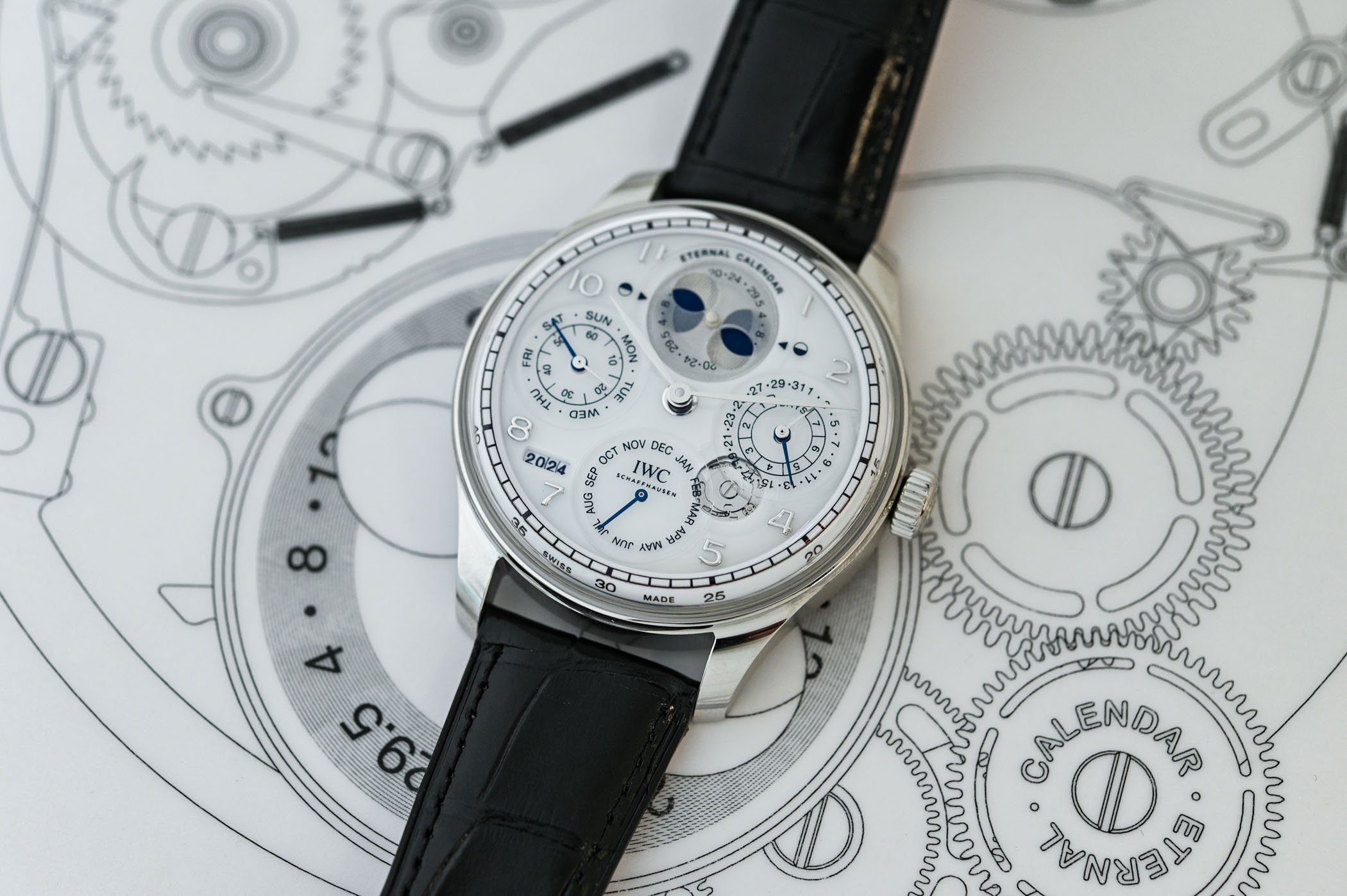IWC Glimpses Eternity with its Secular Calendar, the Portugieser Eternal Calendar (incl. Video)
Eternity is within reach with IWC’s first secular perpetual calendar, which won’t need adjusting until 3999, and a moon phase indicator that will remain accurate for 45 million years!
IWC’s Portugieser Eternal Calendar is the undisputed calendar masterpiece of the Schaffhausen-based brand for Watches and Wonders 2024. A colossal technical milestone, the Eternal Calendar marks the brand’s first secular perpetual calendar. Unlike a perpetual calendar that will need a correction in 2100, the Eternal Calendar is fitted with a 400-year gear that overrides the Gregorian calendar’s complex leap year rule exceptions and skips three leap years over four centuries. In short, it will not need to be adjusted until 3999! Combined with a hyper-precision moon phase display that will deviate from the Moon’s orbit by one day in 45 million years, this Eternal Calendar in a platinum Portugieser case is a tour de force.
Exceptions to the Rule
Since antiquity, astronomers have invented instruments to observe, measure and predict the motions of our universe with ever-increasing accuracy. As explained in this article, calendars are one way of condensing this vast amount of information, and since 1582, the Gregorian calendar has ruled our lives. The reason it has lasted so long is that it is surprisingly accurate thanks to its incorporation of an extra day at the end of February every four years to reflect the real time it takes the Earth to revolve around the Sun.
Known as leap years, adding an intercalary day at the end of February every four years ensures that our calendar stays in sync with nature’s cycles. According to the Gregorian calendar, years that are divisible by four are leap years. To further complicate matters, there are exceptions to the rule. Centurial years ending in 00 that can be divided by 400 are leap years (1600, 2000, 2400, 2800), while centurial years like 2100, 2200 and 2300, which can be divided by 100, are not.
From QP…
Translating this copious information into the miniature realm of watchmaking is a gargantuan task. Watchmakers, though, are dogged souls and have come up with a host of mechanisms to reflect the Gregorian calendar packed inside diminutive spaces. At the top end of the calendar complication is the Perpetual Calendar. Of course, IWC is no newcomer to calendar watches, and Kurt Klaus’ ingenious perpetual calendar mechanism was launched inside the Da Vinci Perpetual Calendar in 1985. Capable of manually synchronising all the displays via the crown, it marked the first QP with a four-digit year display. Automatically recognising the different lengths of the month and the leap year at the end of February every four years, the QP movement requires a small adjustment in the centurial years that skip the leap year – 2100, 2200 and 2300.
…To Eternity
The absolute king of calendar watches is the secular perpetual calendar, a complex beast mastered by only a handful of watchmakers – some of the rare examples: the Patek Philippe Calibre 89, the Perpetuel Secular Calendar by Svend Andersen or the Frank Muller Mega Aeternitas, and two recent introductions, the Audemars Piguet Code 11.59 Universelle and the Furlan Marri Secular Perpetual Calendar.
Capable of accounting for centurial years, IWC’s Eternal Calendar is equipped with a 400-year gear designed to skip three leap years over four centuries. This quantum leap allows it to calculate the leap year correctly until 3999 because, as IWC’s press release states, “it has not yet been officially decided whether the year 4000 will be a leap year or not.”
To tackle the leap year inconsistencies, IWC’s chief design officer Christian Knoop explains that only two gears were added to the gear train. Impressively compact, the 400-year gear has just eight components and responds to the goal of using the least amount of components by combining them in ingenious ways. One of the gears completes one revolution every 400 years, and its three indentations force the calendar to skip three leap years over that period. The wheels are grown using hyper-precision Liga technology.
Unprecedented Precision
IWC’s engineers have also incorporated a moon phase display using a limited number of components but offering unprecedented precision. Deviating from the Moon’s orbit by only one day after 45 million years, IWC’s engineers developed a new reduction gear train using three intermediate wheels between the base movement and the moon phase disc. Surpassing the current moon phase precision record of two million years held by watchmaker Andreas Strehler and his Lune Perpétuelle 2M, IWC has applied for a nomination in the Guinness World Book of Records.
Portugieser Legacy
While it is hard to believe that all this technology is packed inside the 44.4mm diameter platinum case with a thickness of 15mm, the practically non-existent bezel allows a wide, open view of the dial, which is a lesson in elegant, airy design. The Portugieser was chosen for its timeless, pure aesthetics, generous proportions, and instrument legacy. As Christian Knoop explains in our video, the new design codes appearing on the dial will be the blueprint for the rest of the Portugieser collection.
The layout of calendar functions is exactly like those found on Kurt Klaus’ Perpetual Calendar – moon phases at noon, three sub-dials with calendar information and the four-digit year window between 7 and 8 o’clock. Based on the same modular design as the perpetual calendar, all the displays of the Portugieser Eternal Calendar can be advanced using the crown.
Transparency and translucency are the operative words here. The dial and caseback are protected by double-domed sapphire crystals, and the dial is made of glass with a frosted and lacquered white underside. Following the domed contours of the box-glass crystal, the white lacquered minutes flange with its signature Portugieser railway track is also raised.
The calendar sub-dials of the Portugieser Eternal Calendar are also crafted in sapphire crystal and float above the glassy dial, producing a wonderful, ethereal sensation. At noon, IWC incorporates its trademarked double moon phase display, which first appeared in 2003 and represents the Northern and Southern Hemispheres. The slightly opaque glass with two holes reveals the waxing and waning of the two moons set against a guilloché sky. Other signature Portugieser traits are the hand-applied Arabic numerals and elegant leaf-shaped hands.
Calibre 52460
The newly developed IWC-manufactured 52460 calibre is based on the brand’s classic automatic calibre with a large 38mm diameter, a Pellaton winding system and a 7-day power reserve. The bidirectional 18k gold rotor builds up a power reserve of 168 hours in the two barrels. Parts of the winding system are manufactured from zirconium oxide ceramic to prevent them from wearing down. The movement’s finishing is understated in the traditional IWC style, well-executed without being over the top with circular graining and Geneva stripes visible through the box-shaped sapphire caseback (a new feature that’s found on multiple other models in the Portugieser line).
Availability & Price
The IWC Portugieser Eternal Calendar is paired with a handsome black Santoni alligator strap and a platinum folding clasp. The price is CHF 150,000. For more information, please consult iwc.com.


















3 responses
this moon phase makes me dizzy lol
That seems like a useful complication…
And also:
Glad you can still read the time at a glance.
It looks amazing though, if a bit standard.
Quite the engineering accomplishment. I have the old regular PPC. Many interesting things about this story. 1) The watch shown in the pictures and video has the month in July and September. The PPC, regardless of version, cannot be set backward. If the owner sets the calendar too far in the future, they either have to wait for the watch to stop and time to catch up or send it back to IWC for adjustment. So Frank, what is IWC doing with the watch shown? 2) Is the 400 wheel shown under the window on the dial? 3) IWC should really say “It MIGHT need adjustment in the year 4000”. If there is a leap year, it will be in 4000, not 3999, but since we don’t know yet, the word might is more appropriate. 4) Would love to see what comes in the box. How many 1000 / 100 unit year wheels some IWC include (it’s my understanding these units have to be moved by IWC, or replaced as one wheel only has 3 centuries (ie 19XX, 20XX, 21XX). 5) First person to purchase should be Connor MacLeod!!! 🙂